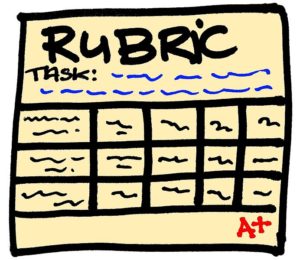 Last night’s #langchat was hopping! One of the most lively discussions had to do with the topic of using rubrics to assess students’ communication in the interpretive mode. So, at the request of @MmeBlouwolff, I’m sharing a few thoughts about how I use rubrics to assess reading in my classes.
Last night’s #langchat was hopping! One of the most lively discussions had to do with the topic of using rubrics to assess students’ communication in the interpretive mode. So, at the request of @MmeBlouwolff, I’m sharing a few thoughts about how I use rubrics to assess reading in my classes.
Like many of my colleagues, I did not understand how I could use a rubric to assess reading comprehension when I first began using IPA’s. It was not until I saw the ACTFL Interpretive template, that I realized I didn’t have to assess comprehension with discrete point measures. After adopting the question types suggested by this guide, the switch to a more holistic grading system made perfect sense. A student’s comprehension is not adequately assessed by the number of questions they answered correctly, any more than their presentational writing can be evaluated by counting spelling errors. Furthermore, our current understanding of the interpretive mode of communication does not limit us to evaluating our students’ literal comprehension of a text. Instead, we are encouraged to assess inferential strategies such as guessing meaning from context, making inferences, identifying the author’s perspective and making cultural connections. Using a rubric to measure student growth on these skills allows me to show my students what they can do, as well as how they can improve their interpretive strategies.
Here’s a look at a sample of student work and how I used a rubric to assess both the student’s literal and interpretive comprehension. Please note that although I relied heavily on ACTFL’s Interpretive IPA Rubric, I changed the format to make it more similar to the Ohio proficiency rubrics that I use for the interpersonal and presentational modes. In addition, I modified some of the wording to reflect my own practices and added a numerical score to each column.
As the completed rubric shows, I ask my students to assess themselves by circling the box which best reflects their own understanding of their performance on each section. In addition to providing an opportunity for self-assessment, this step ensures that the students have a clear understanding of the expectations for the assessment and encourages goal-setting for future performances. This process also provides me with important information about the students’ metacognition. In this case, the student seemed to feel very confident about his/her responses to the Guessing Meaning from Context section, in spite of the fact that he only guessed one word correctly.
After collecting the assessments and student-marked rubrics, it’s my turn to assess the students. The use of a rubric streamlines this process considerably, as I can quickly ascertain where each student’s performance falls without the laborious task of tallying each error. I simply check the appropriate box on the rubric, and then project a key when I return the papers so that each student receives specific feedback on the correct responses for each item.
When it comes to determining a score on the assessment, as a general rule I assign the score for which the student has met all, or nearly all of the descriptors. I do consider, however, how the class does as a whole when assigning numerical grades. I am frequently unrealistic in my expectations for the Guessing Meaning from Context, for example, and as a result I do not weigh this category very heavily when assigning a final score. In the case of this student’s work, I assigned a grade of 9.5/10 as s/he met many of the descriptors for Accomplished and demonstrated greater comprehension than the majority of his/her classmates.
While the use of rubrics for interpretive communication might not work for everyone, I have found that holistic grading provides better opportunities for self-assessment, encourages students by providing feedback on what they can do and saves me time on grading.
As always, I look forward to your feedback, questions and suggestions!
Image credit: https://commons.wikimedia.org/wiki/File:Rubric.jpg
